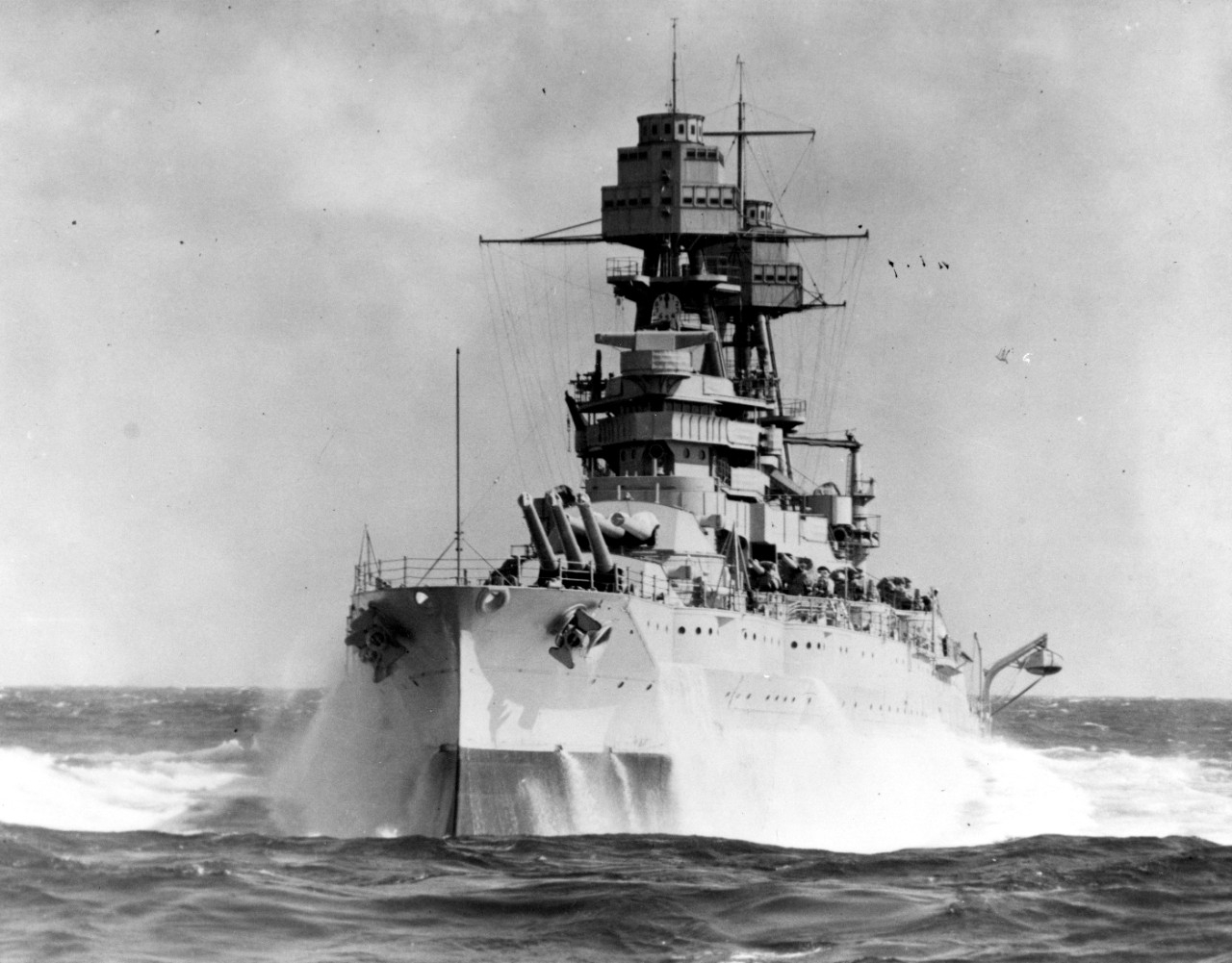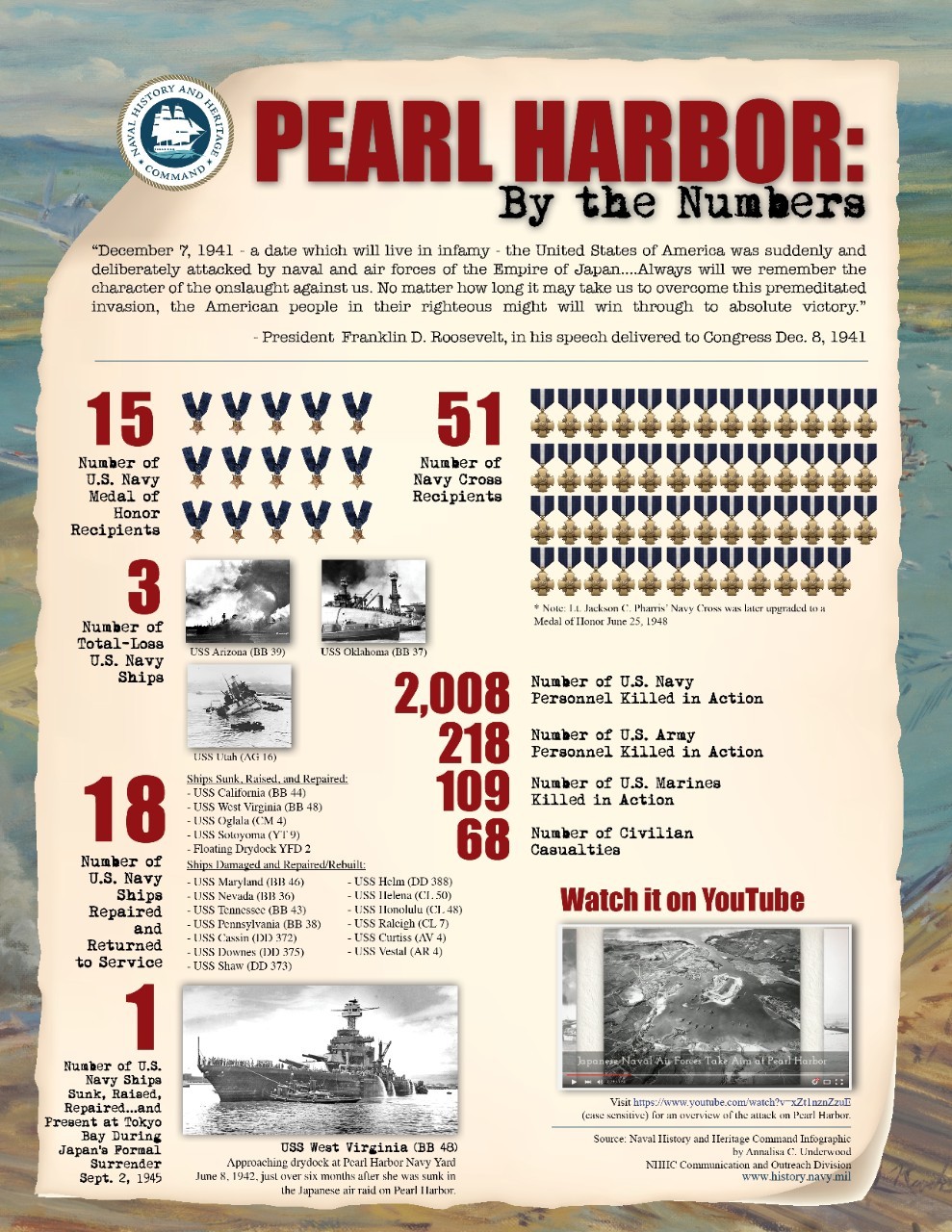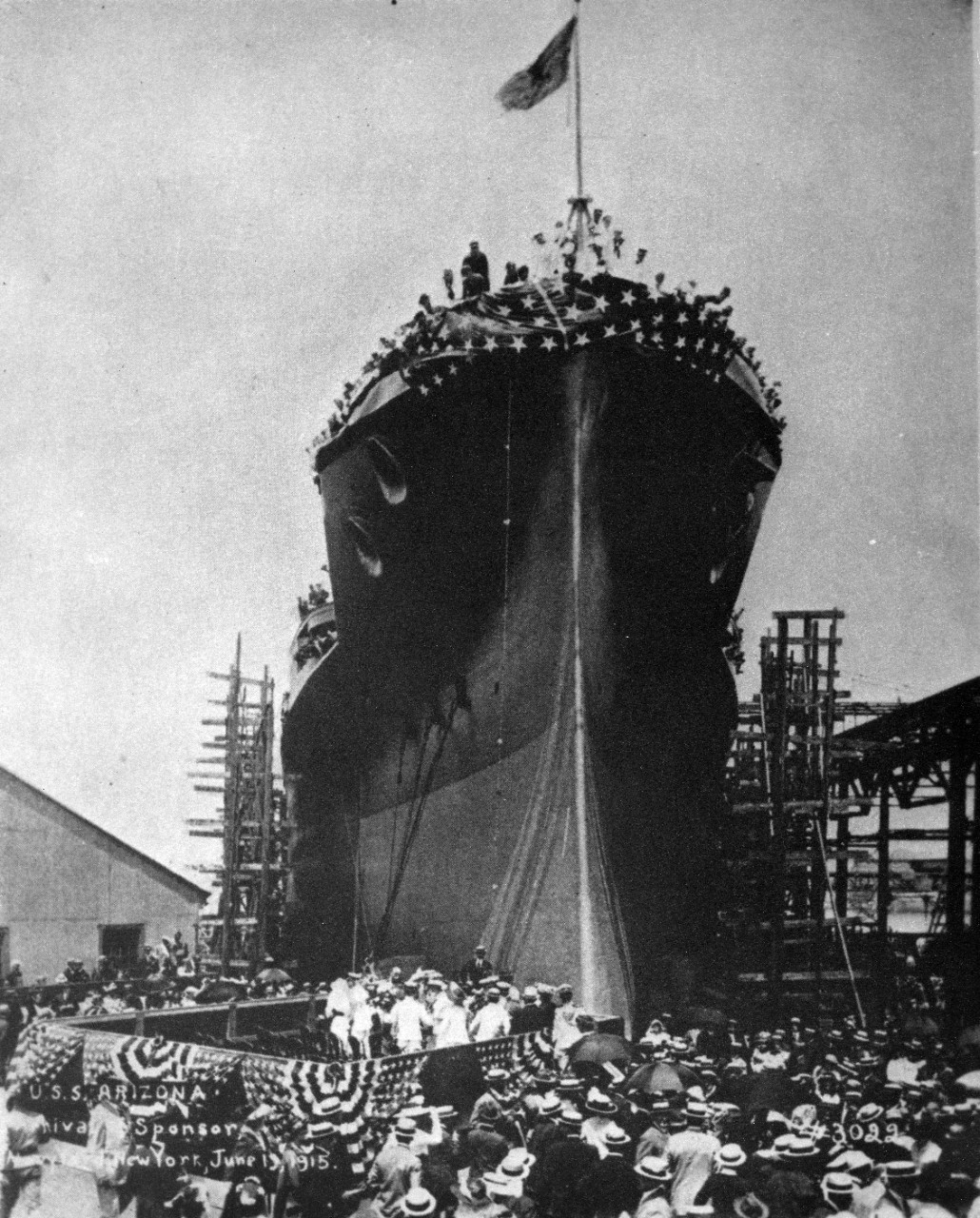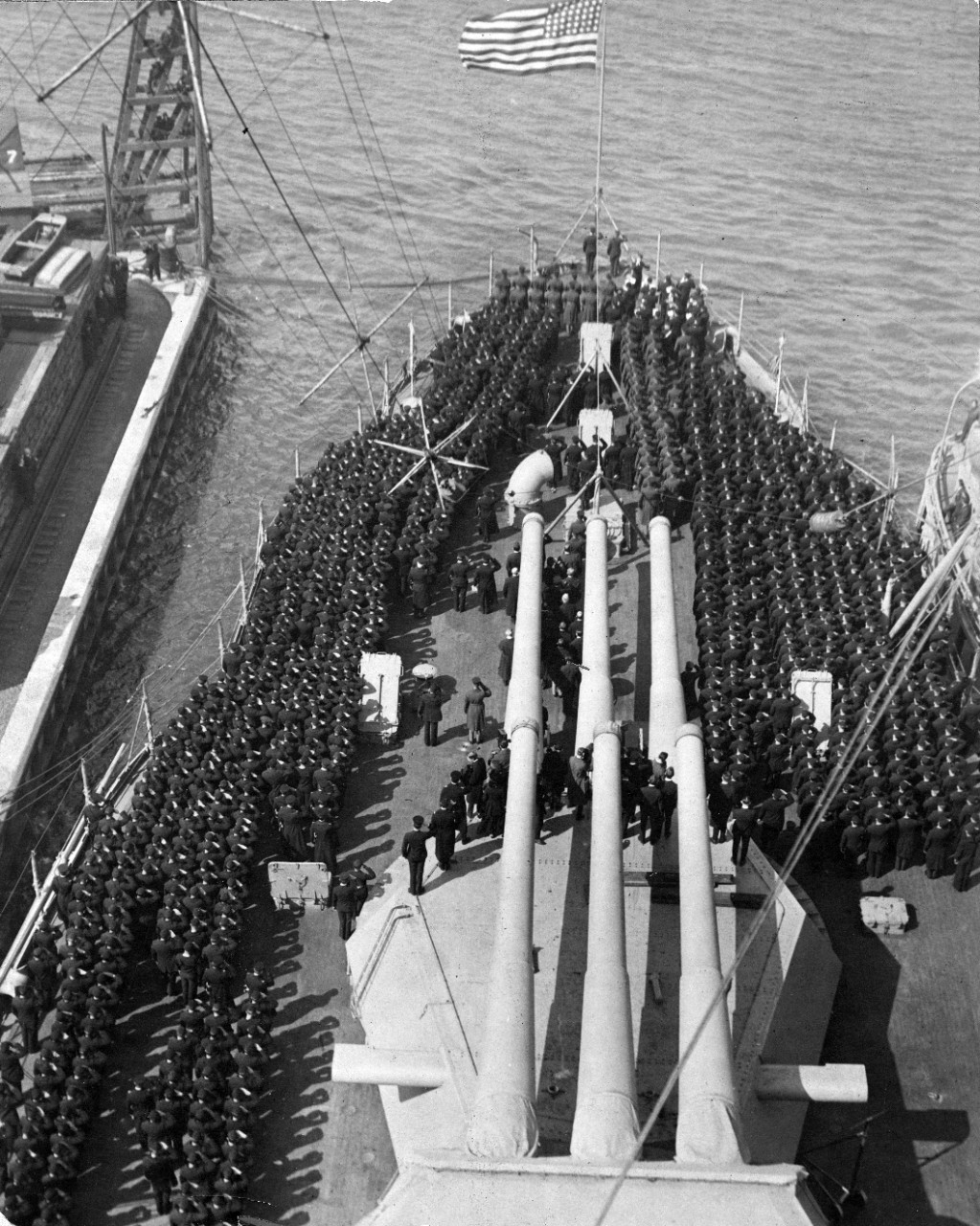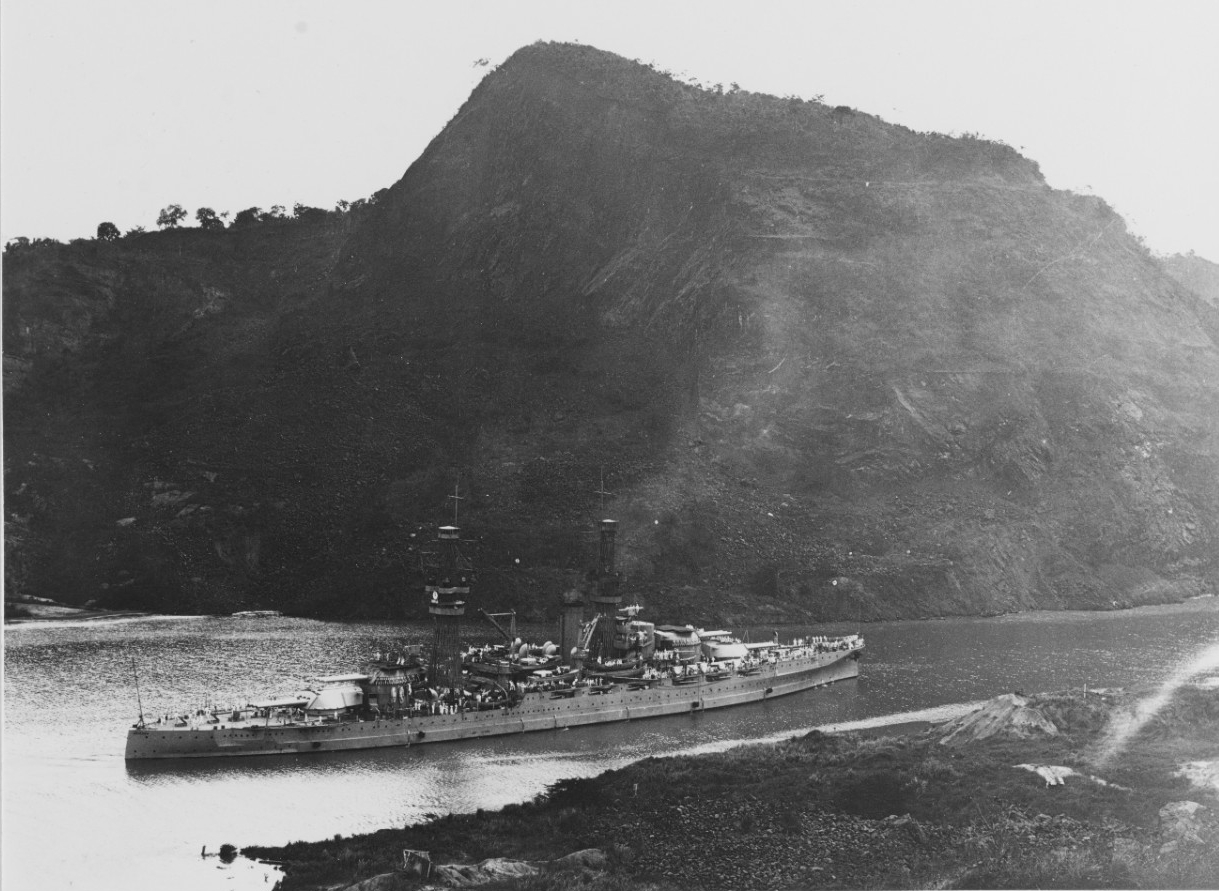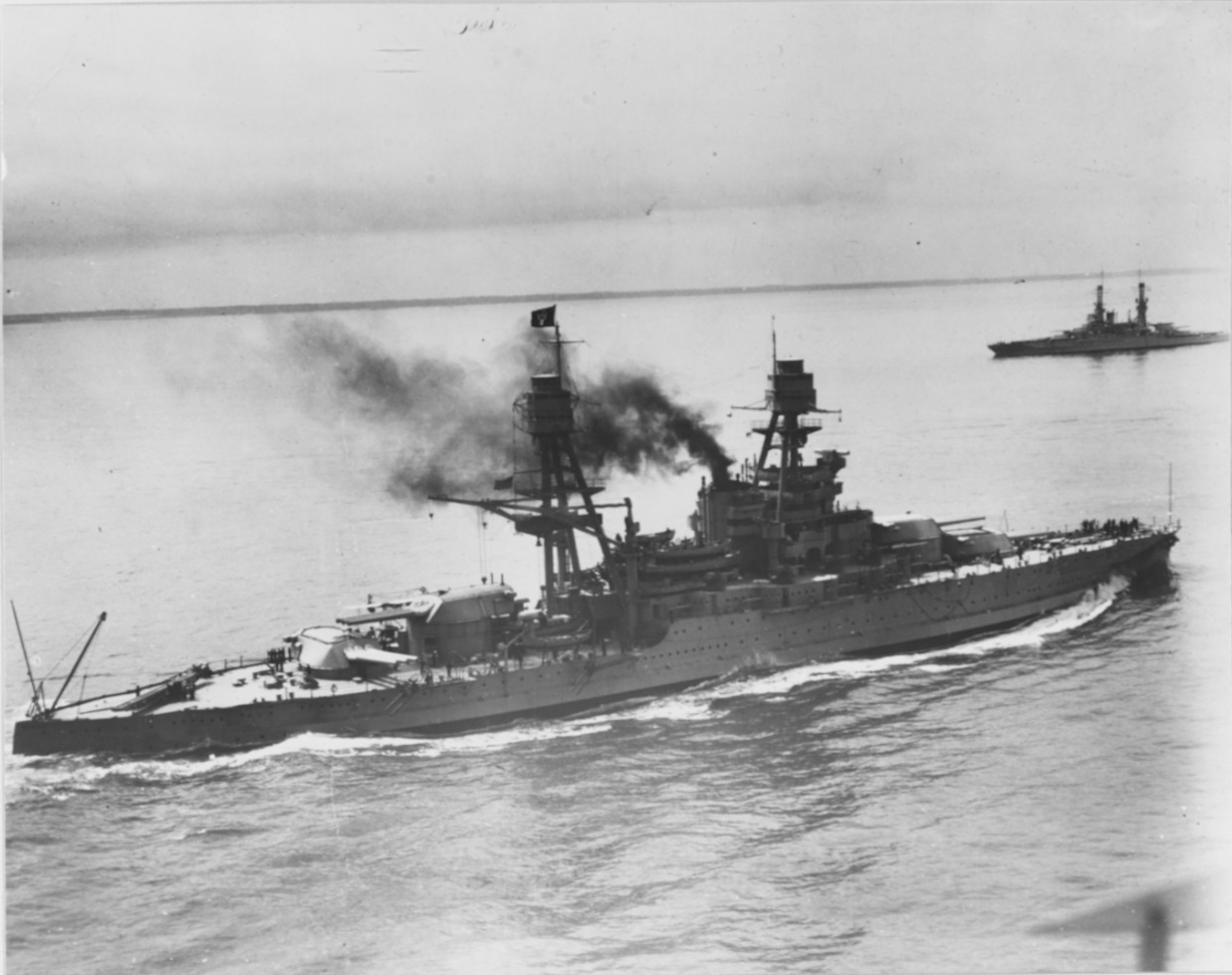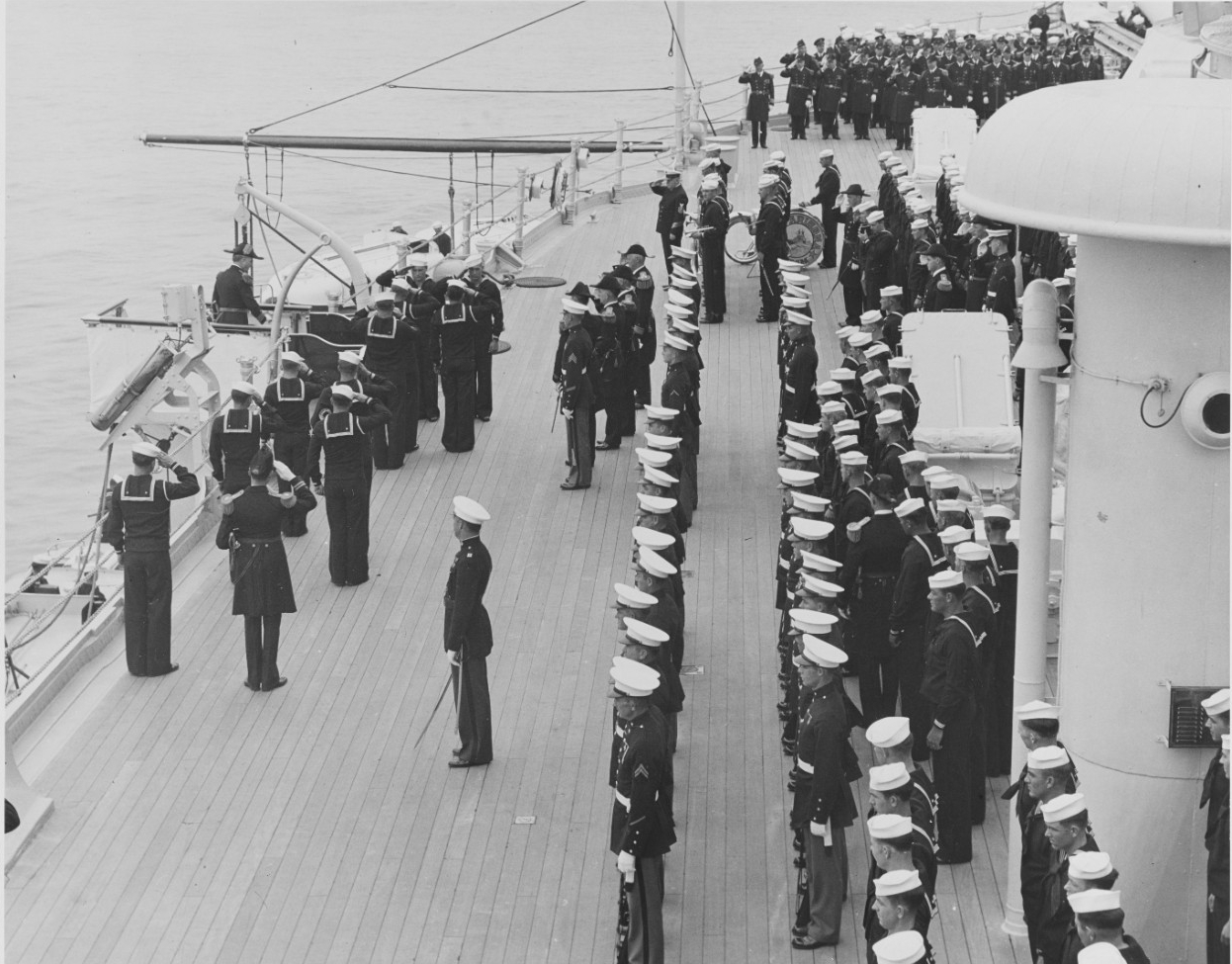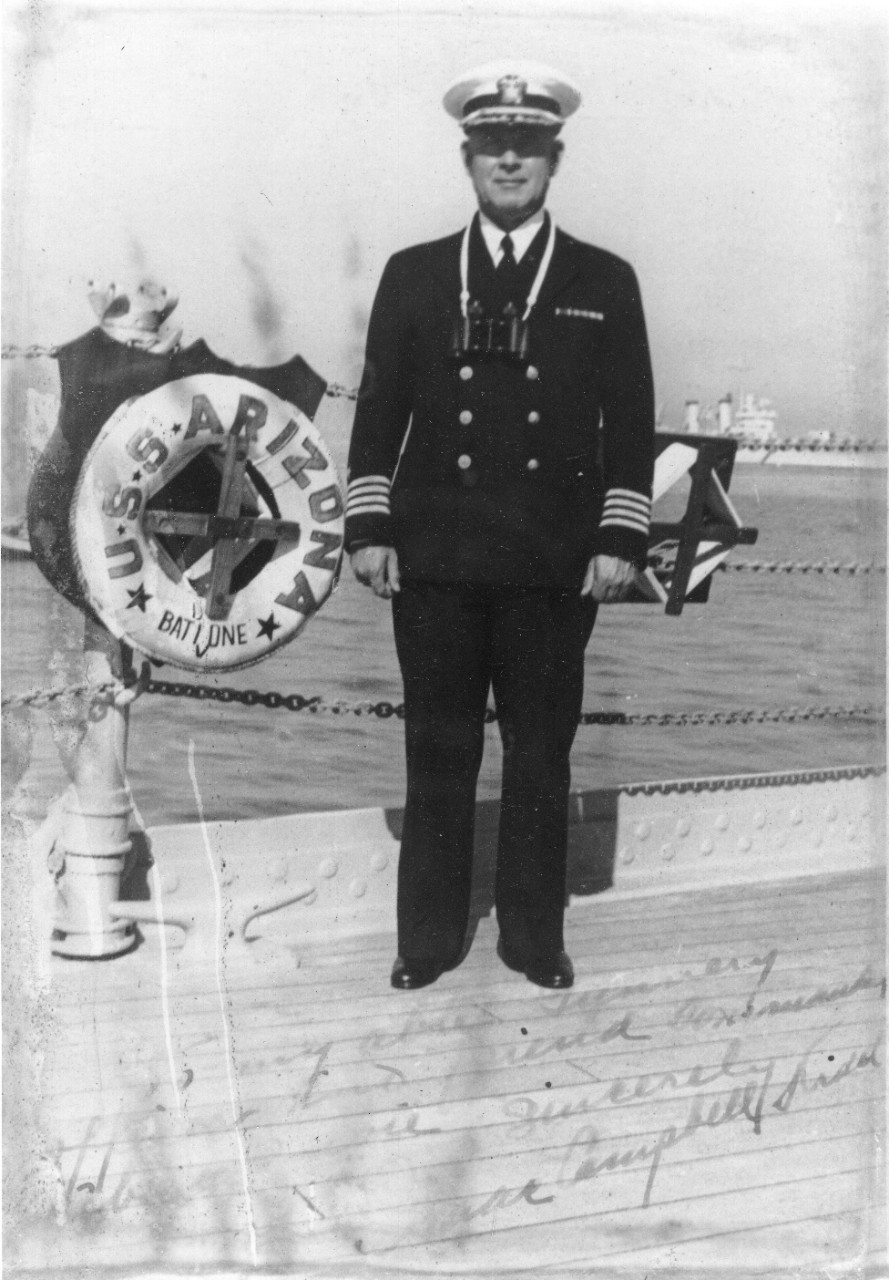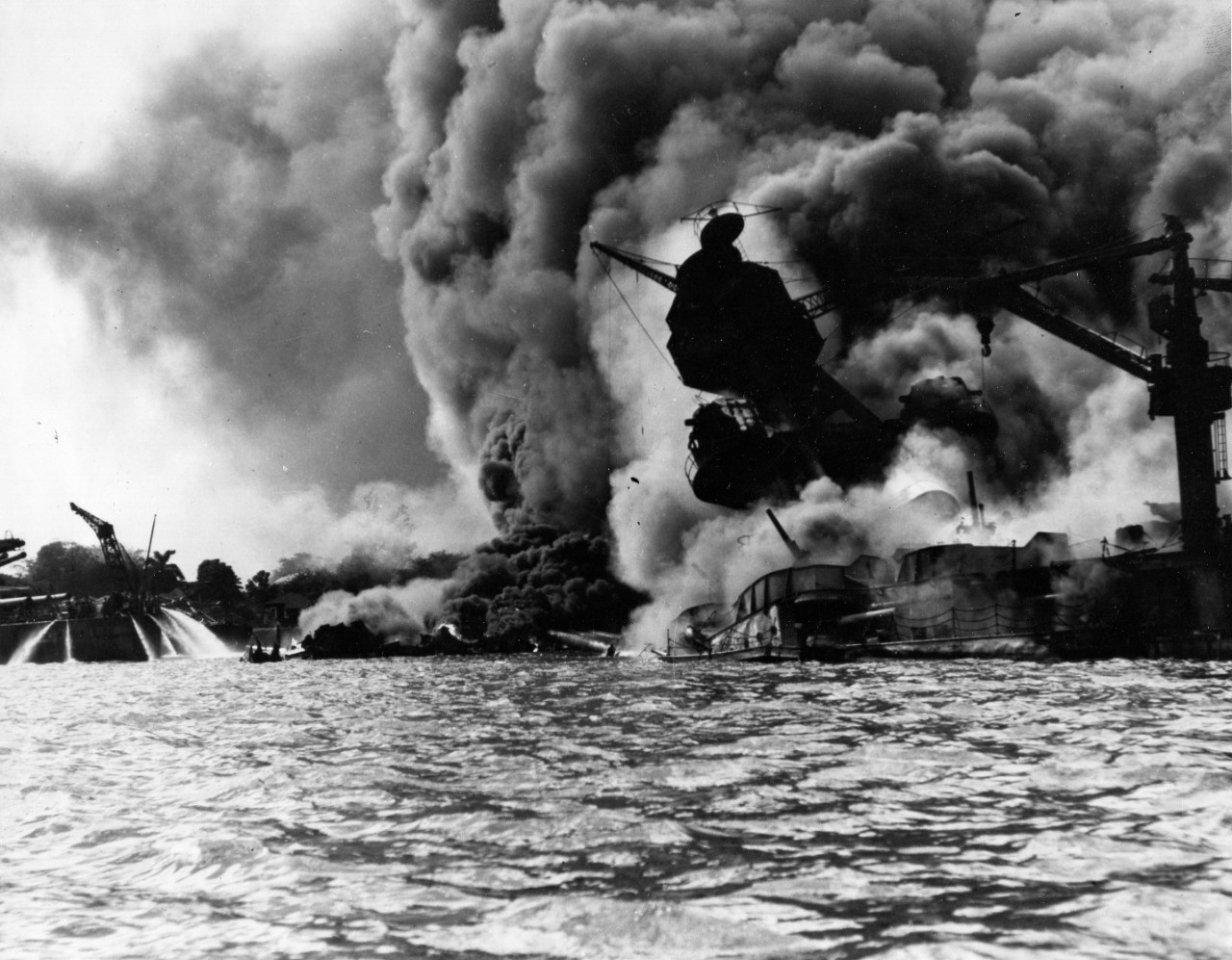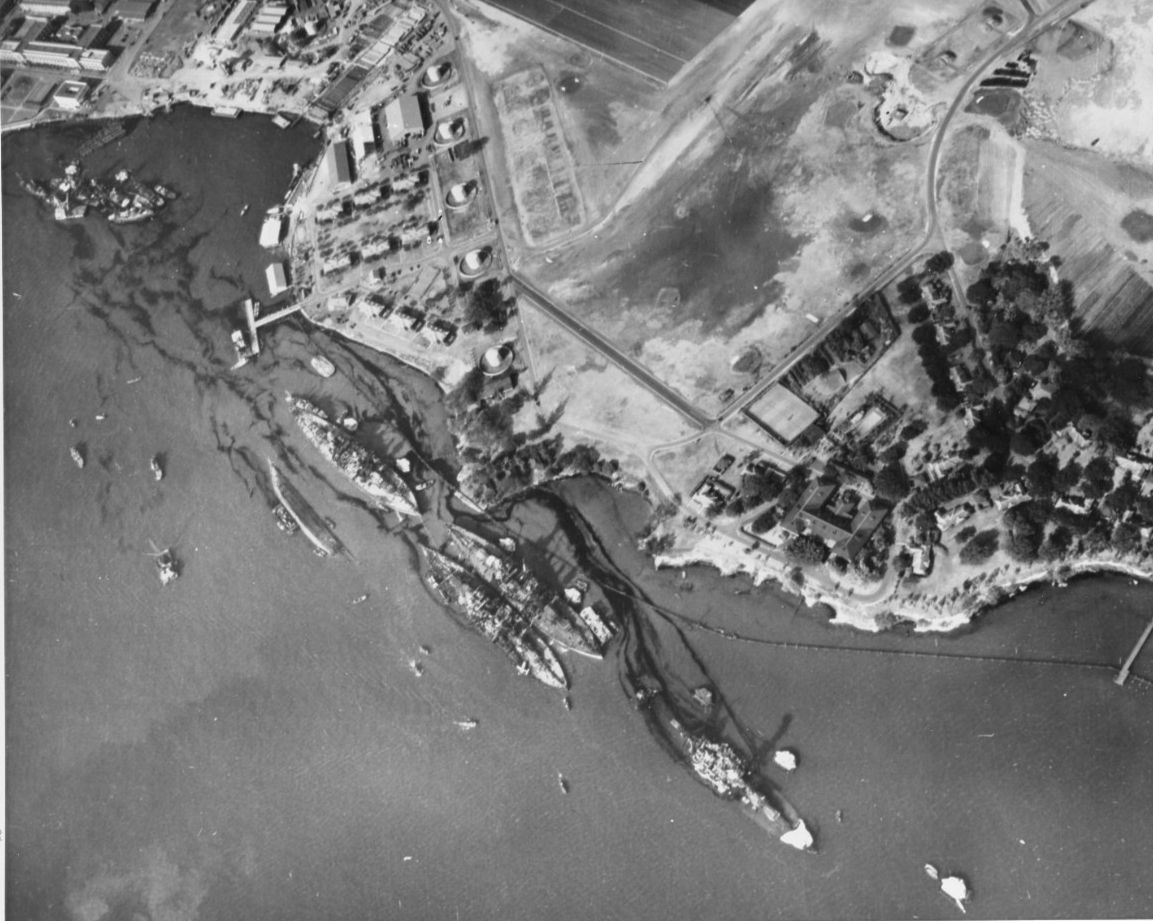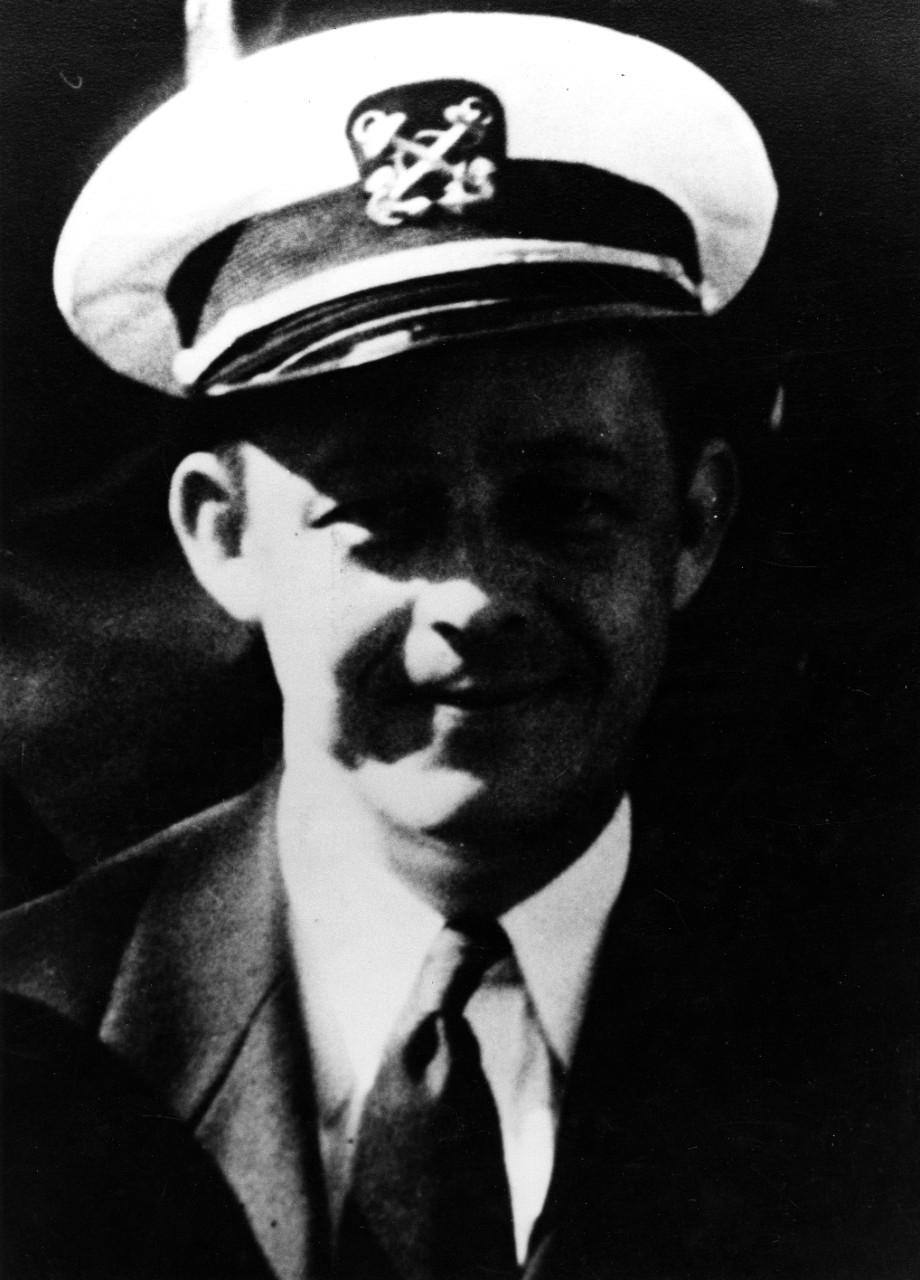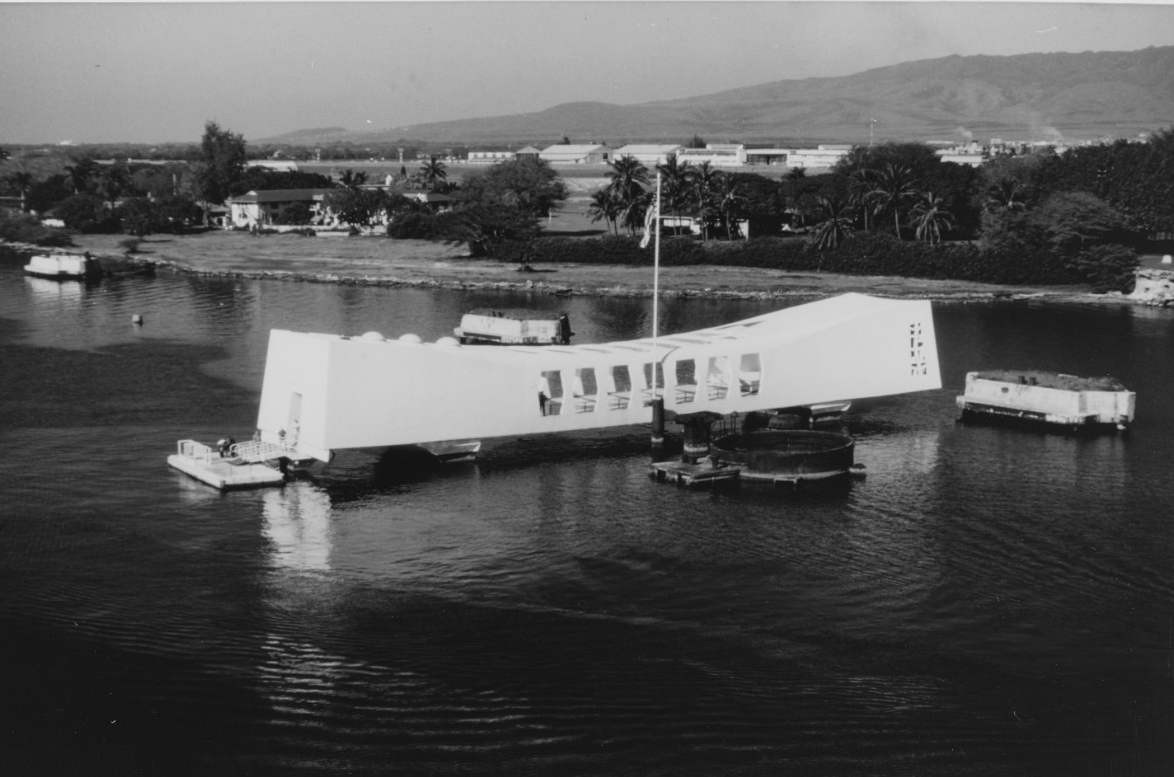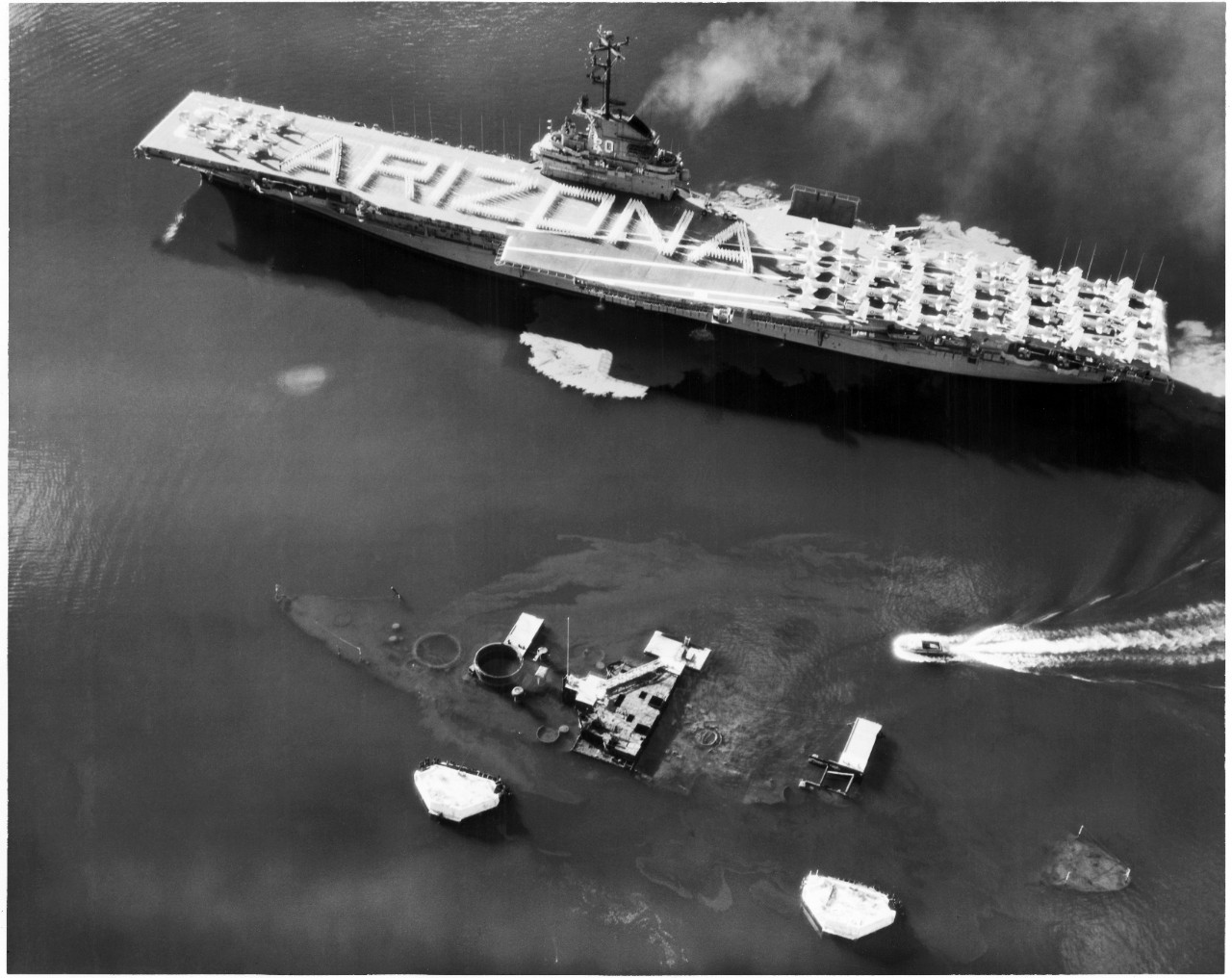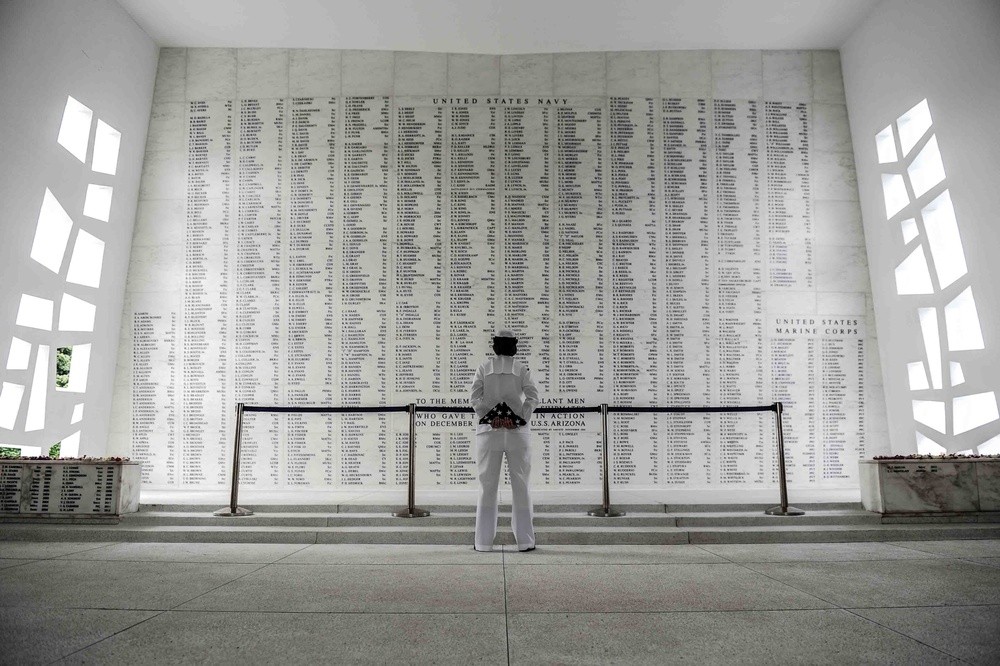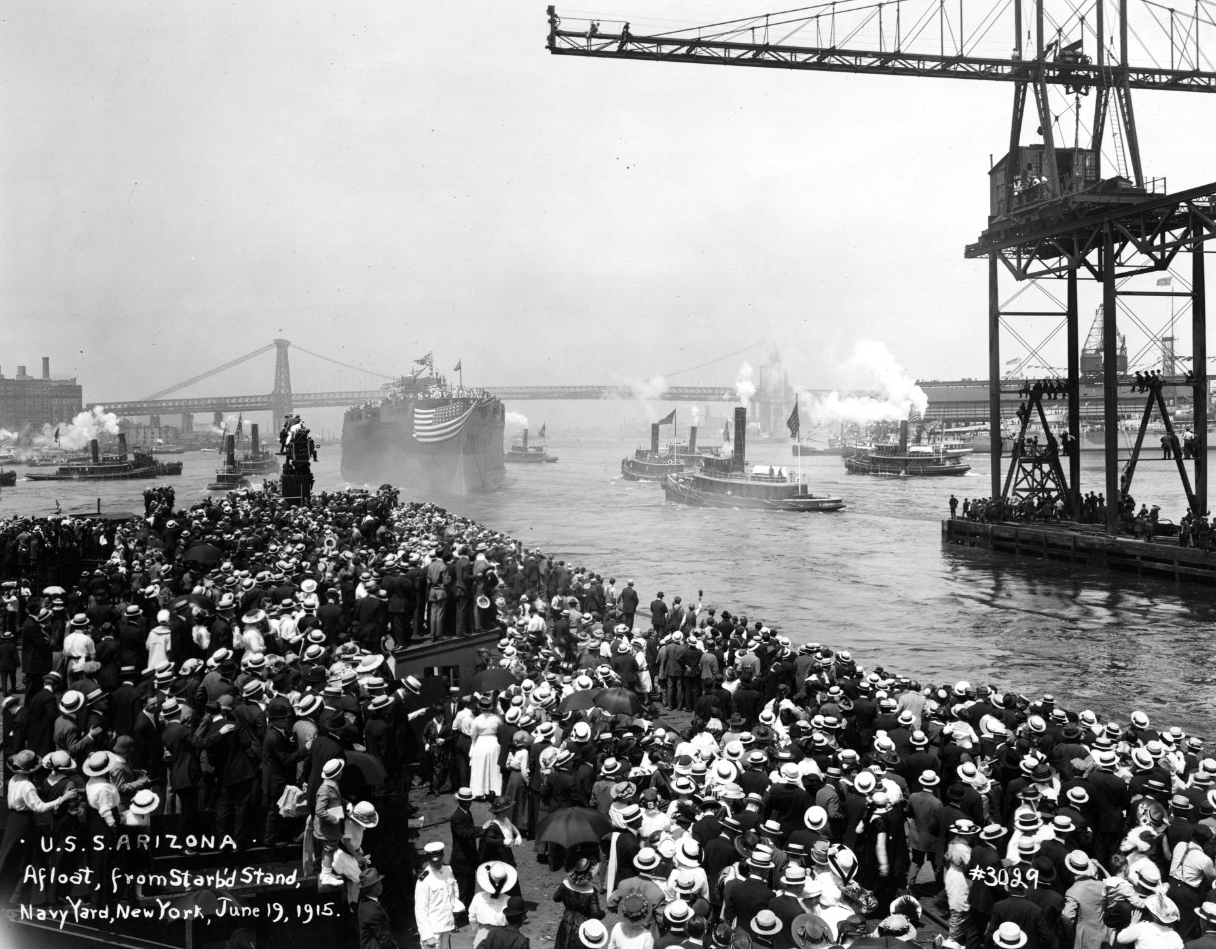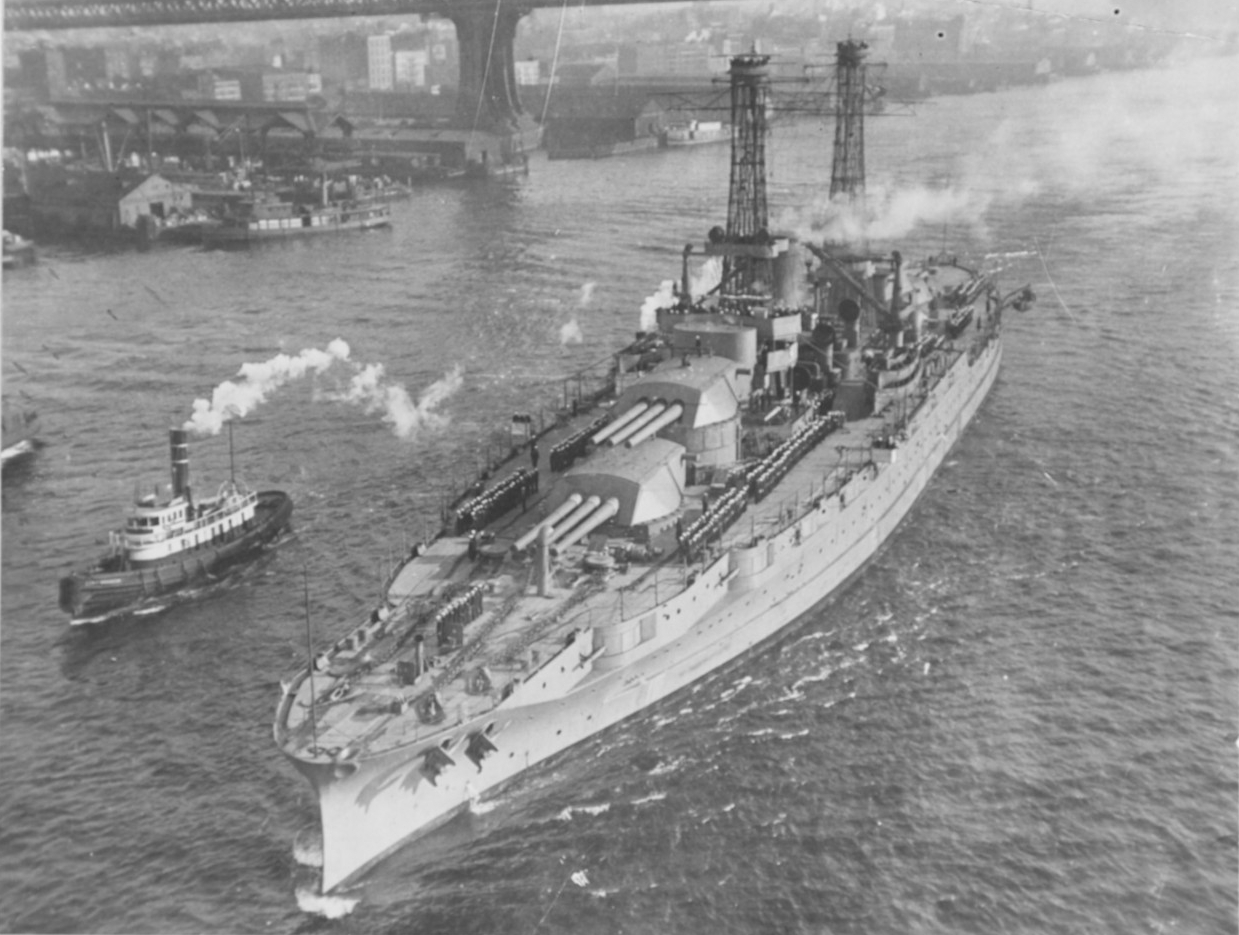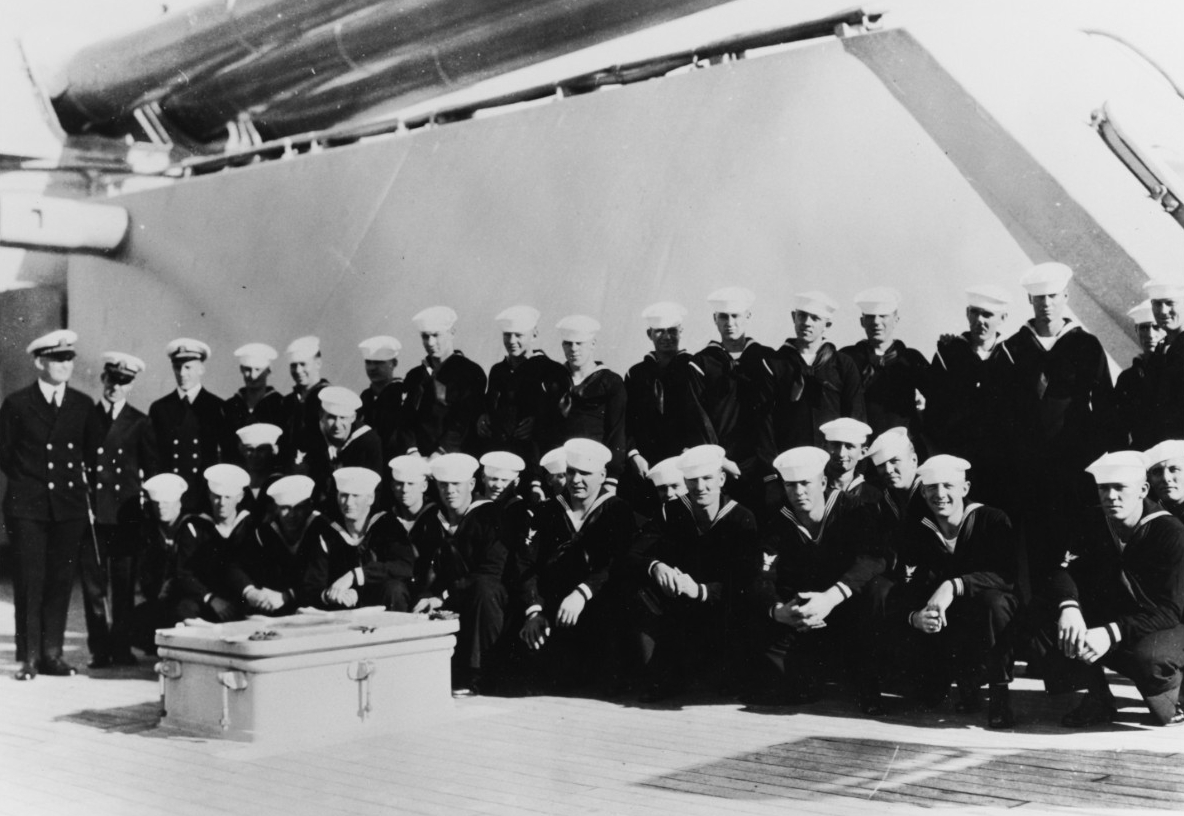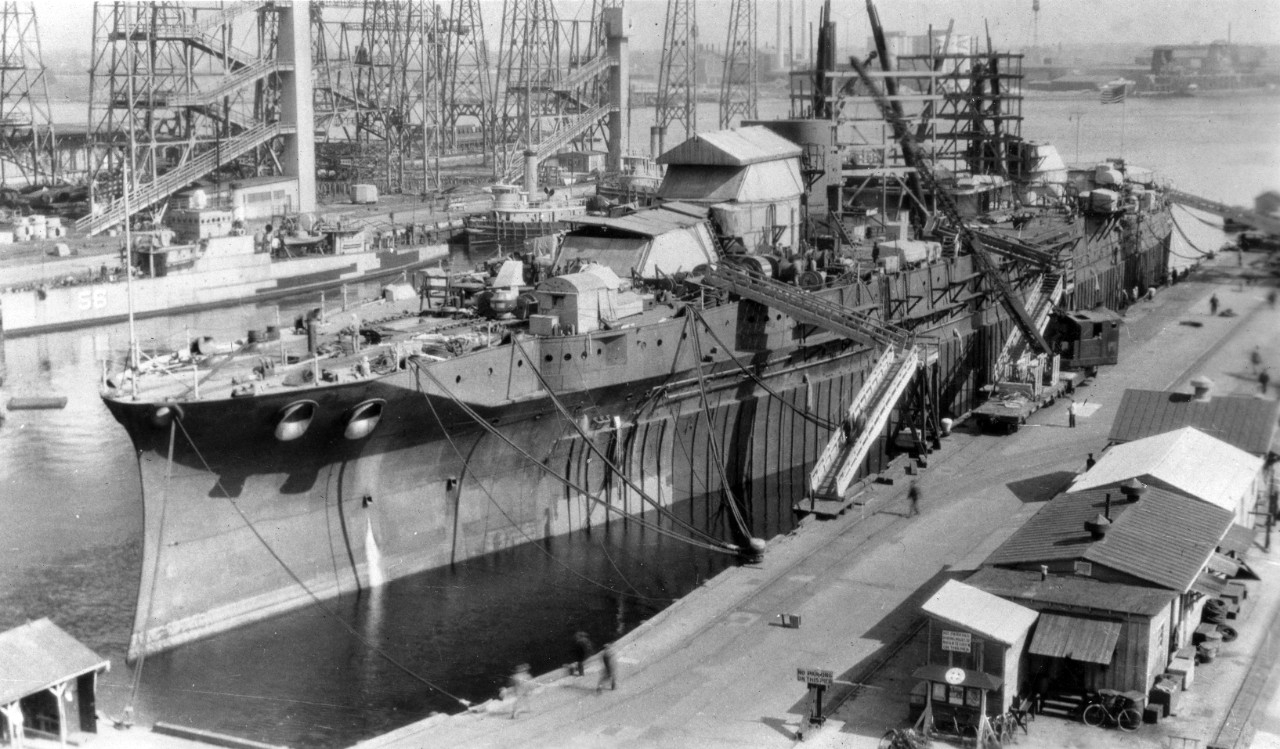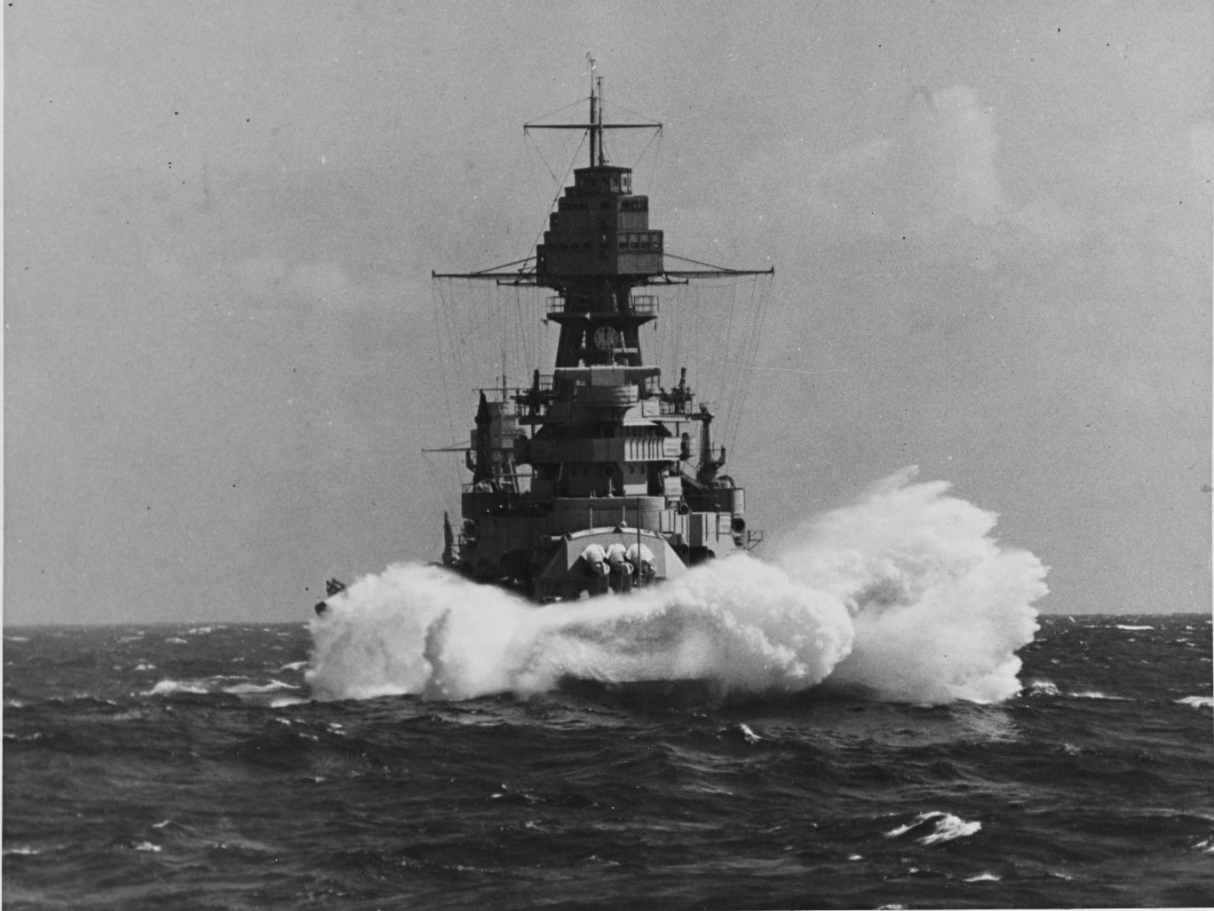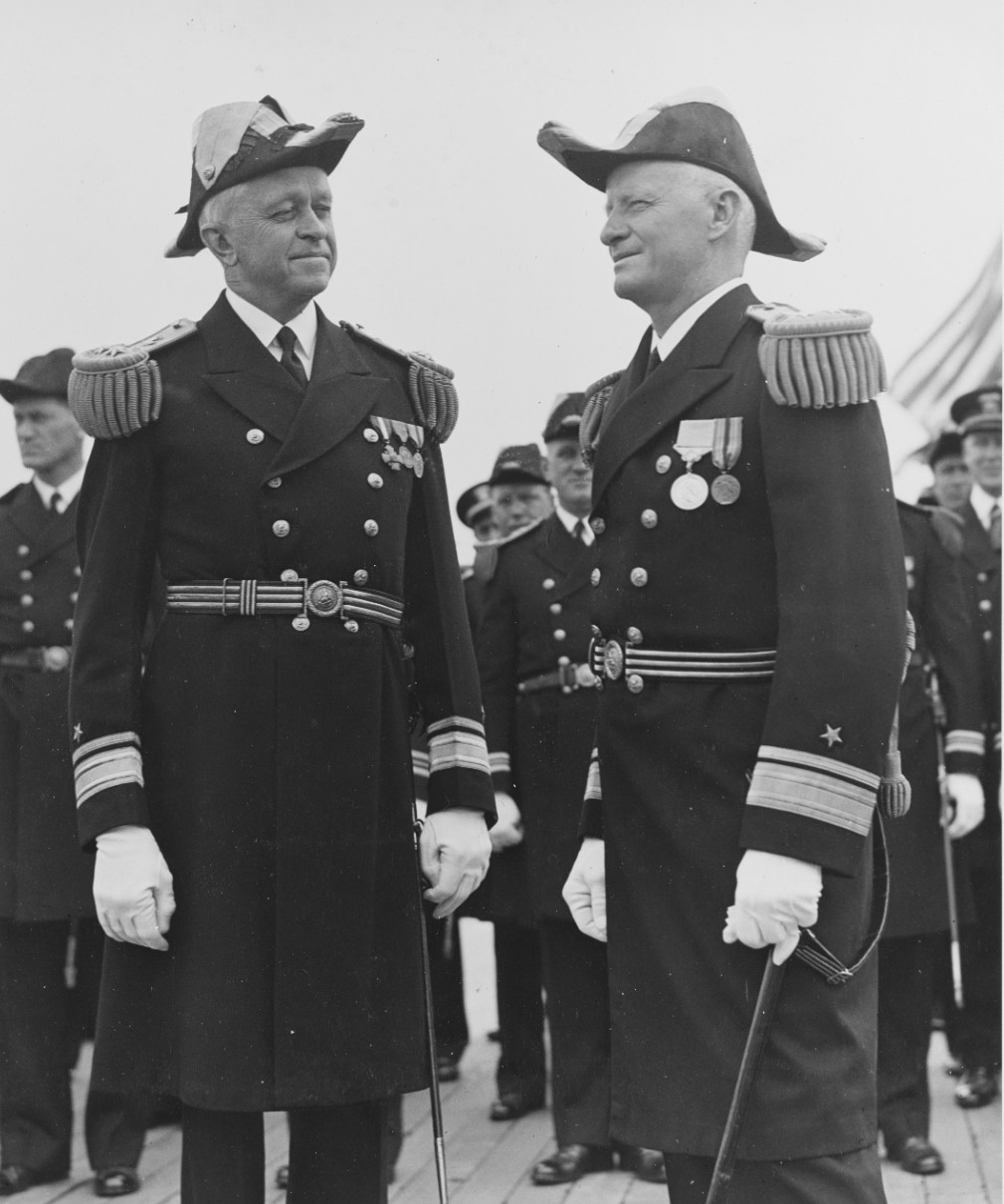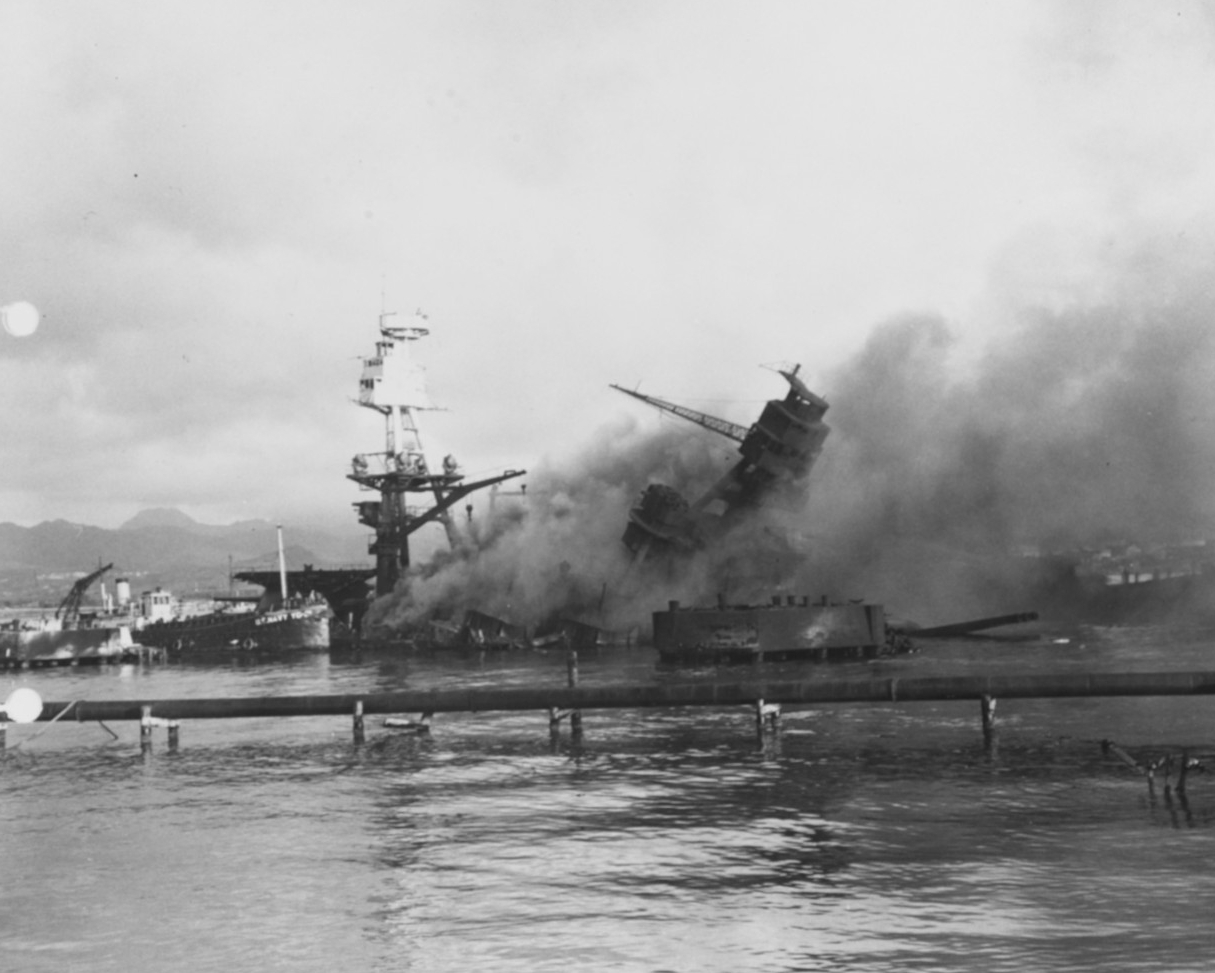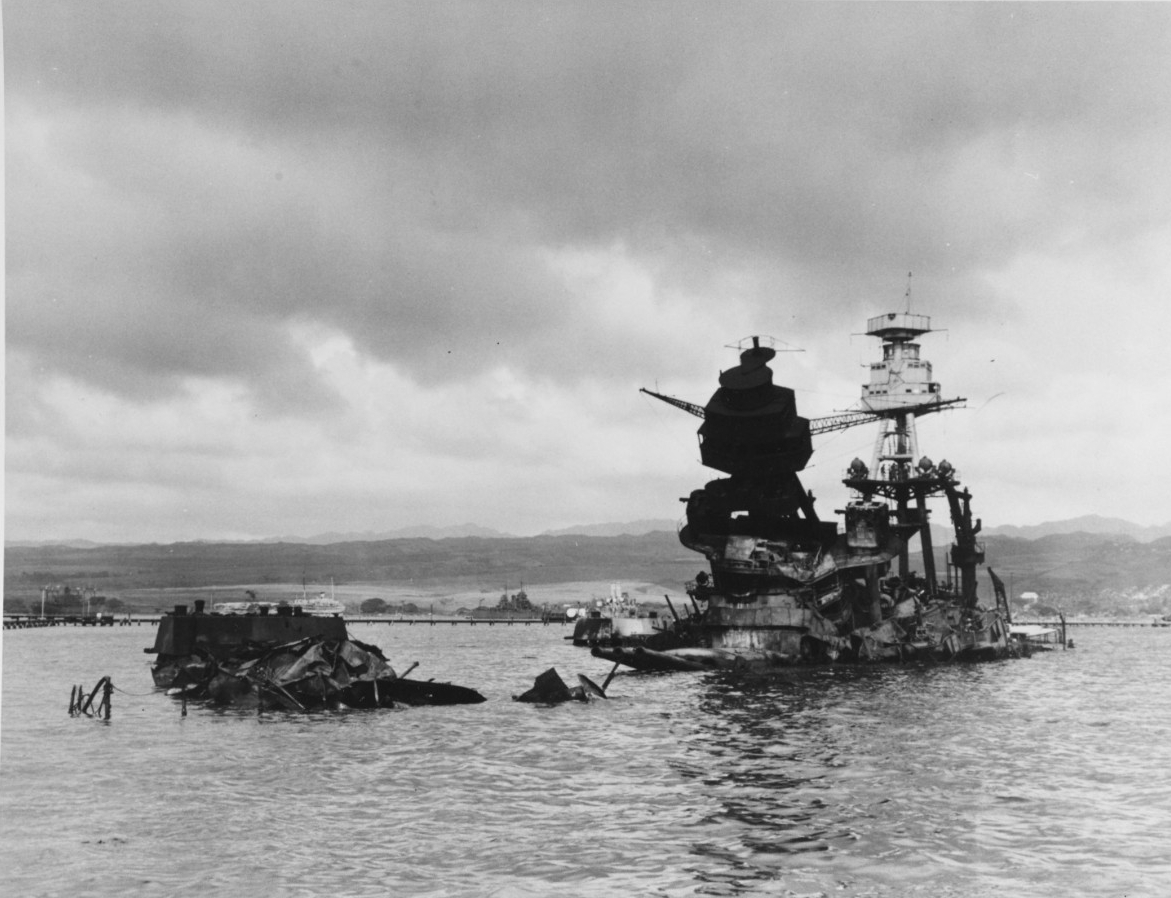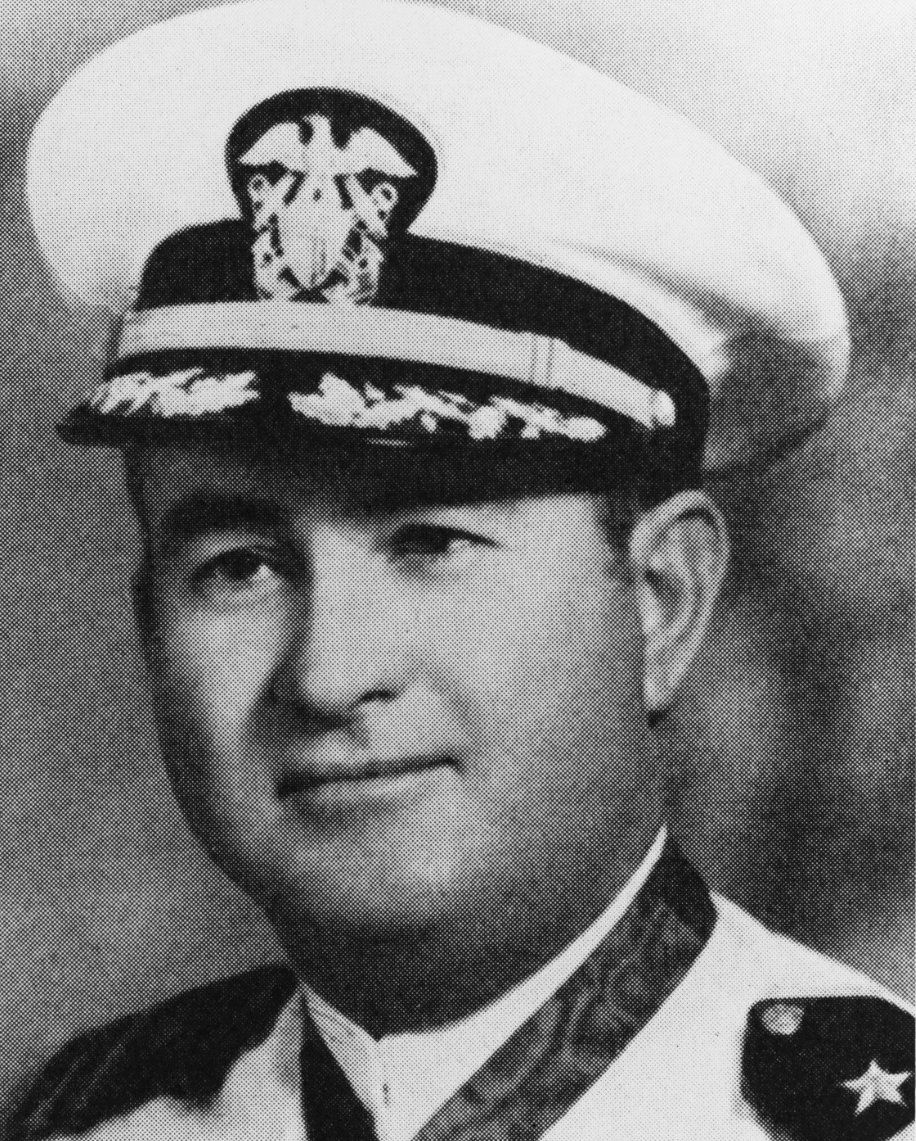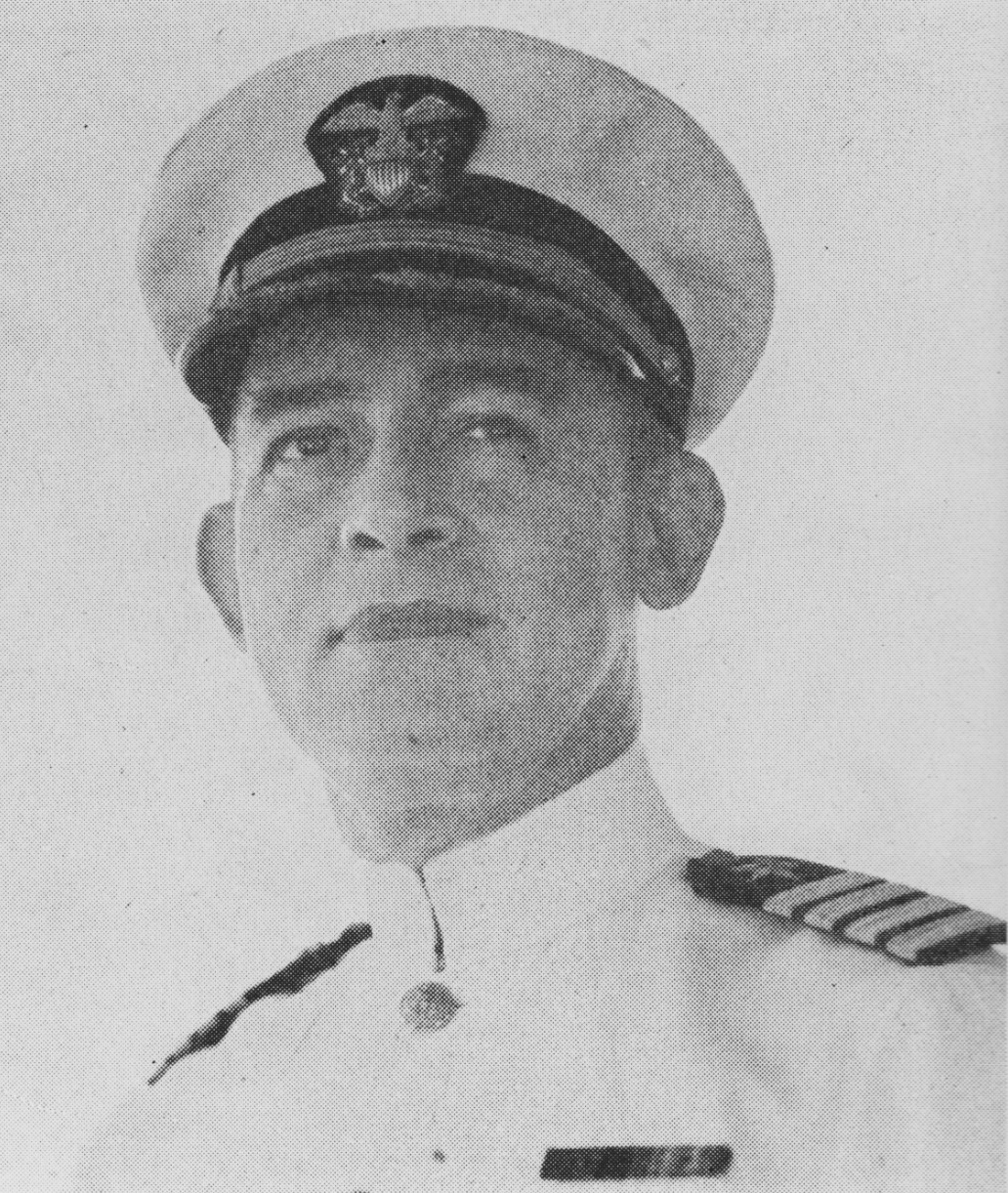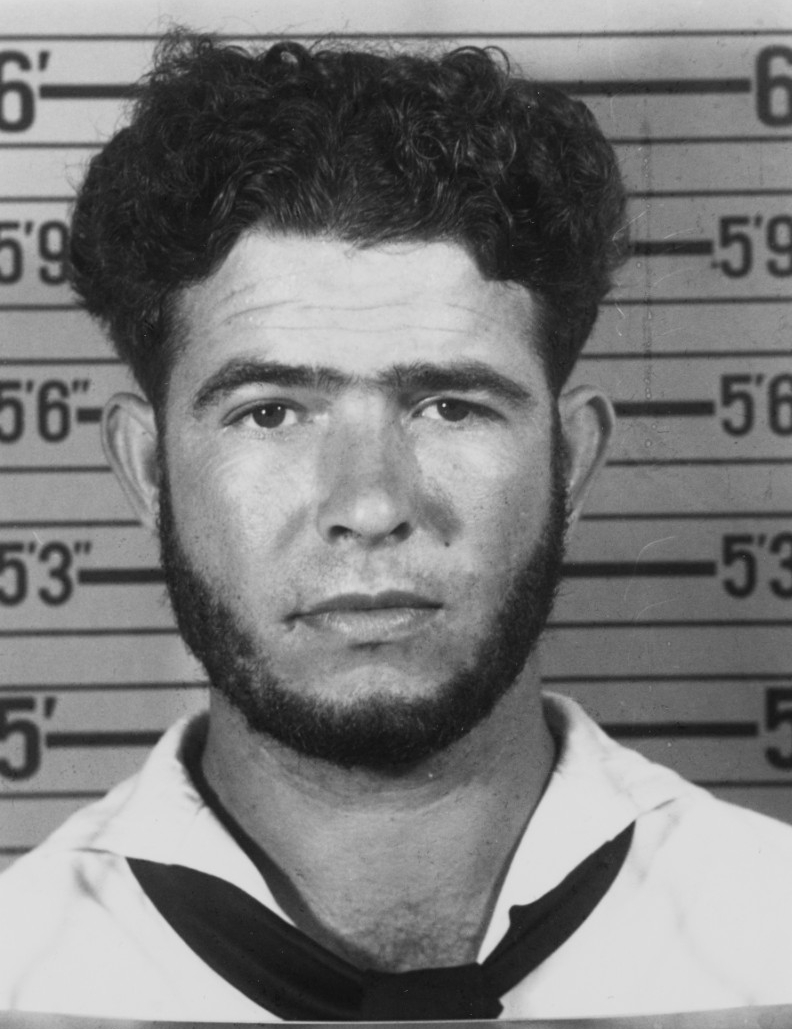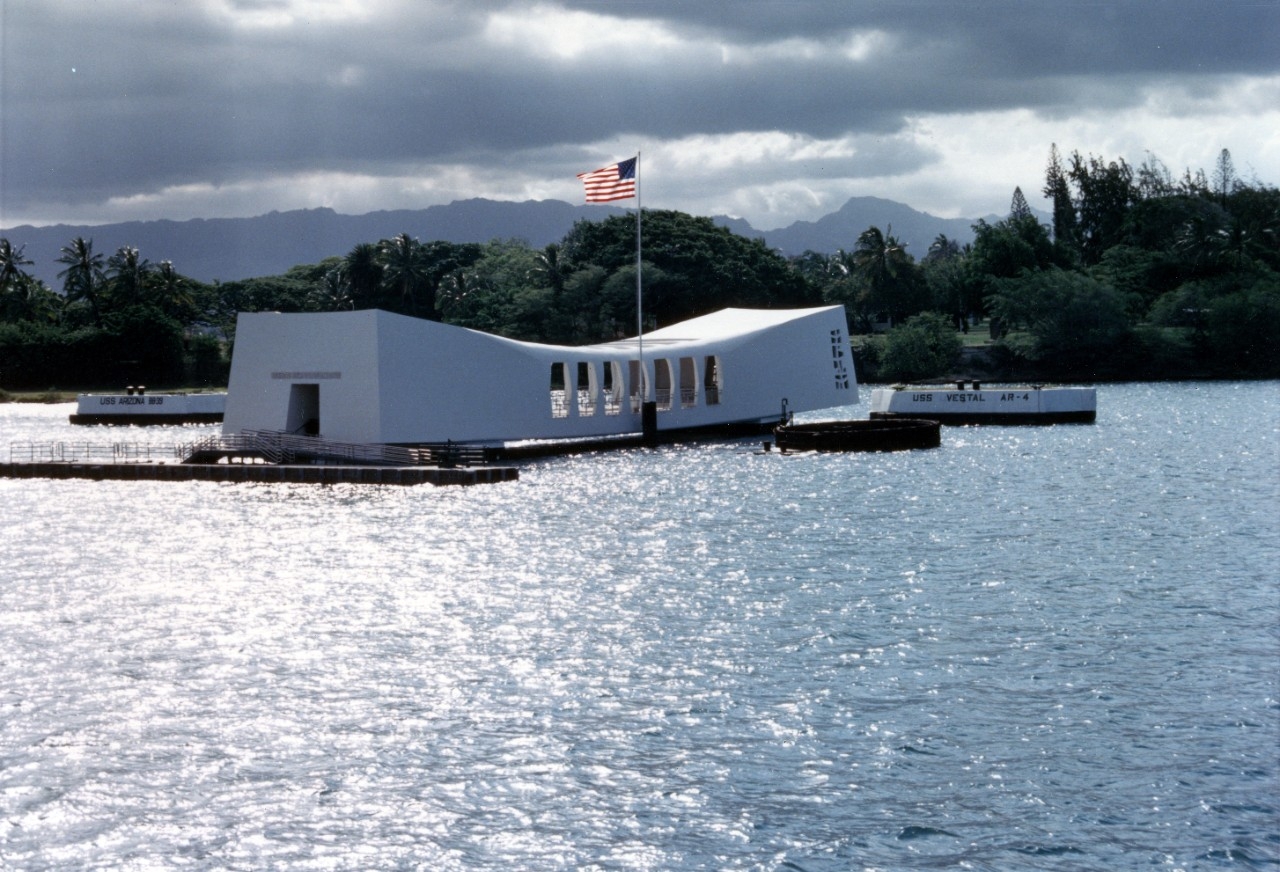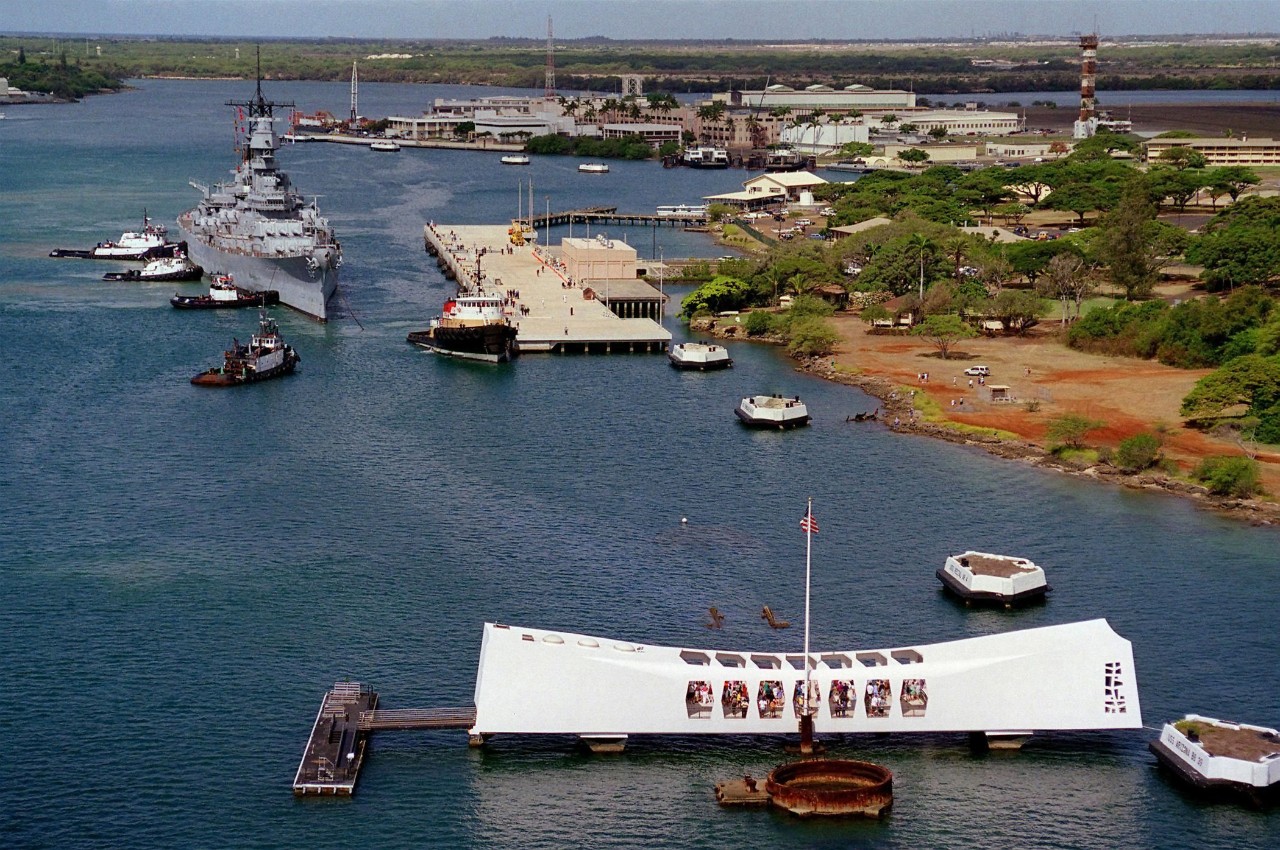USS Arizona (BB-39)
Battleship Arizona (BB-39), named to honor the 48th state, was commissioned at the New York Navy Yard on 17 October 1916, with Captain John D. McDonald in command. After shakedown training off the Virginia Capes, Newport, and Guantanamo Bay, Cuba, she returned to New York on Christmas Eve for post-shakedown overhaul. After repairs were complete on 3 April 1917, she joined Battleship Division 8. During World War I, Arizona operated out of Norfolk, Virginia, serving as a gunnery training ship and patrolling the waters on the eastern seaboard from the Virginia Capes to New York. A week after Armistice was reached on 11 November 1918, Arizona steamed to Portland, England, to rendezvous with transport George Washington, who was carrying President Woodrow Wilson to meet with European leaders. Arizona, one of the newest and most powerful American dreadnoughts, served as part of the honor escort to transport the president to Brest, France. After she embarked 238 homeward-bound veterans of the “Great War,” Arizona set sail from Brest and arrived off Ambrose Light on the afternoon of Christmas Day 1918. The next day, she passed in review before Secretary of the Navy Josephus Daniels, who was in the yacht Mayflower off the Statue of Liberty, before entering New York Harbor in a great homecoming celebration. The battleship then sailed for Hampton Roads, Virginia, on 22 January 1919, and returned to her port at Norfolk on the following day.
On 4 February, Arizona set sail for Guantanamo Bay arriving four days later. After conducting battle practices and maneuvers, the battleship was underway for Trinidad arriving in late March for a three-day port visit. She returned to Guantanamo Bay for a short period before she steamed back to Norfolk arriving on the morning of 12 April. Later that afternoon, Arizona was underway again for Brest, ultimately making arrival there on 21 April. The battleship remained in the Brest Harbor until 3 May, then was underway to Asia Minor and arrived at the port of Smyrna eight days later to protect American lives during the Greek occupation of that port—an occupation resisted by gunfire from Turkish nationals. During that time, she provided temporary shelter for a party of Greek nationals while the battleship’s Marine Detachment guarded the American consulate. On 15 June, Arizona was underway for New York, via Constantinople, Turkey, where she would undergo upkeep.
On 6 January 1920, the battleship cleared the New York port to join Battleship Division 7 for winter and spring maneuvers in the Caribbean. Arizona operated out of Guantanamo Bay during this period. She made port visits to Bridgetown, Barbados, in the British West Indies, and Colon, in the Panama Canal Zone, before she sailed north for New York, arriving there on 1 May 1920. For the next several months, she operated out of New York, where she was given the alphanumeric hull designation, BB-39, on 17 July, and, on 23 August, she became flagship for Rear Admiral Edward W. Eberle’s Battleship Division 7.
Underway from New York on 4 January 1921, Arizona joined the fleet as it sailed for Guantanamo Bay and the Panama Canal. On 19 January, Arizona transited the Panama Canal for the first time, arriving at Panama Bay the following day. While underway, she visited Callao, Peru, and Balboa, before she transited the Panama Canal again en route to New York, arriving on 29 April. She remained there until 15 June for overhaul. For the next couple of months, Arizona participated in various operations and celebrations before she sailed for Panama Bay on 3 August where she became flagship for Battleship Division 7 when Vice Admiral McDonald transferred his flag to battleship Wyoming (BB-32), and Rear Admiral Josiah S. McKean broke his flag on board as commander of the division on 10 August at Balboa. The following day, Arizona was underway for San Diego, California, arriving on 21 August 1921.
For the next nearly two decades, Arizona served as flagship for Battleship Divisions 2, 3 or 4, homeported at San Pedro, California. During this time, she participated with the fleet in the operating areas off the coast of southern California, in the Caribbean, and in the northern Pacific. In July 1929, she underwent a 20-month modernization that included: tripod masts, surmounted by three-tiered fire control tops, replaced the old cage masts; and 5-inch, 25-caliber antiaircraft guns replaced the 3-inch 50-caliber weapons with which she had been equipped. She also received additional armor to help protect her from torpedo or near-miss damage from bombs, and she received new boilers as well as new main and cruising turbines.
On 17 September 1938, Arizona became the flagship for Battleship Division 1, when Rear Admiral Chester W. Nimitz broke his flag. Detached on 27 May 1939 to become Chief of the Bureau of Navigation, Nimitz was relieved on that day by Rear Admiral Russell Willson.
At the conclusion of Arizona’s last fleet problem, XXI, the United States Fleet was retained in Hawaiian waters based at Pearl Harbor. She operated in Hawaiian waters until late summer, before she returned to Long Beach, California, on 30 September 1940. She was then overhauled at the Puget Sound Navy Yard, Bremerton, Washington, into the following year. Her last flag change-of-command occurred on 23 January 1941, when Rear Admiral Isaac C. Kidd relieved Rear Admiral Willson as Commander, Battleship Division 1.
Arizona returned to “Pearl” on 3 February 1941 to resume training with the Pacific Fleet. Over the next several months, Arizona continued exercises and battle problems in Hawaiian waters. She underwent a brief overhaul at the Pearl Harbor Navy Yard, where she received the foundation for a search radar atop her foremast. She conducted a night firing exercise on the night of 4 December 1941 with USS Nevada (BB-36) and USS Oklahoma (BB-37). Afterwards, all three ships moored at quays (“keys”) along Ford Island on 5 December, with Arizona mooring at berth F-7. Scheduled to receive a tender availability, Arizona took the repair ship USS Vestal (AR-1) alongside her port side the next day. The two ships were moored together on the morning of 7 December. Among the men on board Arizona that morning were Rear Admiral Kidd and Captain Franklin van Valkenburgh, Arizona’s captain.
Shortly before 0800 on Sunday, 7 December, Japanese carrier attack planes and bombers, supported by fighters, numbering 353 aircraft from six aircraft carriers, unleashed a massive attack on the U.S. Pacific Fleet at Pearl Harbor in two waves, as well as nearby naval and military airfields and bases. On board Arizona, the air alarm went off about 0755, and the ship went into general quarters. Arizona took two direct bomb hits. One of the hits that likely doomed the ship came from the 800-kilogram bomb dropped by a Nakajima B5N2 Type 97 carrier attack plane commanded by Japanese Lieutenant Commander Kasumi Tadashi, of the carrier Hiryu’s air unit, that glanced off the face plate of Turret II and penetrated the deck to explode in the black powder magazine, which in turn set off adjacent smokeless powder magazines. A catastrophic explosion ripped through the forward part of Arizona that caused debris to rain down in the vicinity of the attack on Ford Island—severe fires burned for two days. The explosion and subsequent sinking took the lives of 1,177 of the 1,512 men on board the ship. Arizona suffered more than half the casualties of the Pearl Harbor attack.
Acts of heroism were abundant on that day on board Arizona. Lieutenant Commander Samuel G. Fuqua, the ship’s first lieutenant and senior surviving officer, rushed to the quarterdeck at the commencement of the attacks, but was subsequently knocked unconscious by the explosion of a large bomb which hit the quarterdeck, penetrated several decks, and started a severe fire. When he regained consciousness, he began to direct the fighting of the fires and the rescue of the wounded and injured personnel. Even with the tremendous explosion, severe enemy bombing and strafing, and the whole forward part of the ship in flames, Fuqua, according to his Medal of Honor citation, “continued to direct the fighting of the fires in order to check them while the wounded and burned could be taken from the ship, and supervised the rescue of these men in such an amazingly calm and cool manner and with such excellent judgment that it inspired everyone who saw him and undoubtedly resulted in the saving of many lives.” Rear Admiral Kidd, the first flag officer killed in the Pacific War, and Capt. Van Valkenburgh, received the Medal of Honor posthumously.
Arizona was placed in ordinary at Pearl Harbor on 29 December 1941, and was stricken from the Naval Vessel Register about a year later. Her wreck was cut down so that very little of the ship lay above water. Other parts of her ship, such as her main battery turrets and guns were removed to be emplaced as coastal defense weaponry.
Arizona’s wreck still to this day remains at Pearl Harbor—a memorial to her crew that lost their lives on that fateful day. On 7 March 1950, Admiral Arthur W. Radford, commander-in-chief of the Pacific Fleet, instituted the raising of Colors over Arizona’s remains, and legislation during the administrations of Presidents Dwight D. Eisenhower and John F. Kennedy designated the wreck a national shrine. A memorial was built spanning the ship, and it was dedicated on 30 May 1962.
Arizona received one battle star for her World War II service.
*****
Suggested Reading
- USS Arizona Action Report of Pearl Harbor Attack
- USS Arizona (BB-39) Wreck Site—1941: A Battleship Preserved as a Lasting Memorial of the Attack on Pearl Harbor
- Fair Winds, Donald Stratton, USS Arizona Hero
- Chief Boatswain's Mate Joseph L. George, USN: Bronze Star
- Surface Navy
- Passing Honors, National Anniversaries, and Solemnities
- CinCPac Report—Pearl Harbor
- Overview of the Pearl Harbor Attack, 7 December 1941
- H-Gram 001-1: Pearl Harbor, 7 December 1941
- DPAA: History and Recovery Efforts of the USS Arizona (BB-39)
- Pearl Harbor National Memorial
Artifacts
- Commemorative pendant from the christening of battleship Arizona (BB-39), circa 1914
- Arizona (BB-39) dance card pendant
- 1917 Christmas menu napkin from battleship Arizona (BB-39)
Interviews with USS Arizona (BB-39) crewmembers
Video Footage
- Wreckage of USS Arizona (BB-39) at Pearl Harbor
- USS Arizona (BB-39) Memorial Dedication Pearl Harbor, Hawaii, 30 May 1962
Infographic
This infographic depicts the impact of the 7 December 1941 attack on Pearl Harbor. A “day that will live in infamy,” the attack on Pearl Harbor inspired the nation and motivated the American people to wholeheartedly commit to the victory in the Second World War. (U.S. Navy photo illustration by Annalisa Underwood/Released/HI816)
Selected Imagery
Captain Isaac C. Kidd, commanding officer of USS Arizona (BB-39), on the deck of his ship, circa 1939. Kidd was awarded the Medal of Honor posthumously in wake of the Pearl Harbor attack on 7 December 1941. He was a rear admiral at the time of the attack. Naval History and Heritage Command photograph, NH 97385.
USS Arizona (BB-39) sunk and burning at Pearl Harbor, 7 December 1941. Her forward magazines had exploded when she was hit by a Japanese bomb. At left, men on the stern of USS Tennessee (BB-43) were using fire hoses on the water to force burning oil away from their ship. National Archives photograph, 80-G-19942.
Aerial view of Battleship Row moorings on the southern side of Ford Island, 10 December 1941, showing damage from the Japanese attack three days earlier. In the upper left was the sunken USS California (BB-44), with smaller vessels clustered around her. Diagonally, from left center to lower right are: USS Maryland (BB-46), lightly damaged, with the capsized USS Oklahoma (BB-37) outboard. A barge is alongside Oklahoma supporting rescue efforts. USS Tennessee (BB-43), lightly damaged, with the sunken USS West Virginia (BB-48) outboard. USS Arizona (BB-39), sunk, with her hull shattered by the explosion of the magazines below the two forward turrets. Note dark oil streaks on the harbor surface, originating from the sunken battleships. National Archives photograph, 80-G-387565.
USS Bennington (CVA-20) passed the wreck of USS Arizona (BB-39) in Pearl Harbor, Hawaii, on Memorial Day, 31 May 1958. Bennington's crew was in formation on the flight deck spelling out a tribute to Arizona's crewmembers, who were lost in the 7 December 1941 Japanese attack on Pearl Harbor. Official U.S. Navy photograph, USN 1036055.
Aviation Structural Mechanic 2nd Class Jennifer Usenick reads the list of fallen service members following Colors onboard the USS Arizona Memorial in Pearl Harbor, Hawaii, 7 November 2014. The memorial marks the resting place of more than 1,000 Sailors and Marines, who were killed aboard USS Arizona (BB 39) during the 1941 attack on Pearl Harbor. U.S. Navy photo by Mass Communication Specialist 3rd Class Amber L. Porter.
Commander Samuel Glenn Fuqua, who received the Medal of Honor for heroism and distinguished conduct in action while serving on board USS Arizona (BB-39) during the 7 December 1941 Japanese attack on Pearl Harbor. He was a Lieutenant Commander at that time. Naval History and Heritage Command photograph, NH 92306.
Tugs move USS Missouri (BB-63) to her berth at Ford Island (background). The berth was roughly where battleships Maryland (BB-46) and Oklahoma (BB-37) were moored on 7 December 1941. The 184 foot-long USS Arizona Memorial in the foreground spans the mid-portion of the sunken battleship USS Arizona (BB-39), 22 June 1998. National Archives identifier, 6610003.

